weight MERCEDES-BENZ GL-Class 2015 X166 Owner's Manual
[x] Cancel search | Manufacturer: MERCEDES-BENZ, Model Year: 2015, Model line: GL-Class, Model: MERCEDES-BENZ GL-Class 2015 X166Pages: 462, PDF Size: 9.09 MB
Page 14 of 462

Fuse box under rear bench sea
t.... 404
Important safety notes .................. 402 G
Garage door opener Clearing the memory ..................... 368
General notes ................................ 365
Important safety notes .................. 366
Opening/closing the garage doo r..3 68
Programming (button in the rear-
view mirror) ................................... 366
Gear indicator (on-board com-
puter) ................................................. .289
Genuine parts ...................................... 24
Glove box .......................................... .343
GTW (Gross Trailer Weight) (defini-
tion) .................................................... 427 H
Handbrake see Parking brake
Hazard warning lamps ......................132
Headlamps Fogging up ..................................... 135
see Automatic headlamp mode
Head restraints
Adjusting ....................................... 108
Adjusting (electrically) ................... 109
Adjusting (manually) ..................... .109
Adjusting (rear) .............................. 110
Installing/removing (rear) .............. 110
Luxury ............................................ 109
Heating
see Climate control
High-beam headlamps
Adaptive Highbeam Assist ............. 134
Changing bulbs .............................. 139
Display message ............................ 306
Switching on/off ........................... 132
Hill start assist .................................. 171
HOLD function Deactivating ................................... 219
Display message ............................ 315
Function/notes ............................ .218 Hood
Closing .......................................... .373
Display message ............................ 324
Important safety notes .................. 372
Opening ......................................... 372
Horn ...................................................... 34
Hydroplaning ..................................... 198 I
Ignition lock see Key positions
Immobilizer .......................................... 78
Indicator lamps see Warning and indicator lamps
Indicators
see Turn signals
Insect protection on the radiator .... 373
Inspection see ASSYST PLUS
Instrument cluster
Overview .......................................... 35
Warning and indicator lamps ........... 36
Instrument cluster lighting .............. 274
Interior lighting Automatic control .......................... 136
Delayed switch-off (on-board
computer) ...................................... 287
Emergency lighting ........................ 137
Manual control ............................... 136
Overview ........................................ 135
Reading lamp ................................. 135
Setting the brightness of the
ambient lighting (on-board com-
puter) ............................................. 286
Setting the color of the ambient
lighting (on-board computer) ......... 286 J
Jack Storage location ............................ 388
Using ............................................. 431
Jump starting (engine) ......................397 12
Index
Page 22 of 462
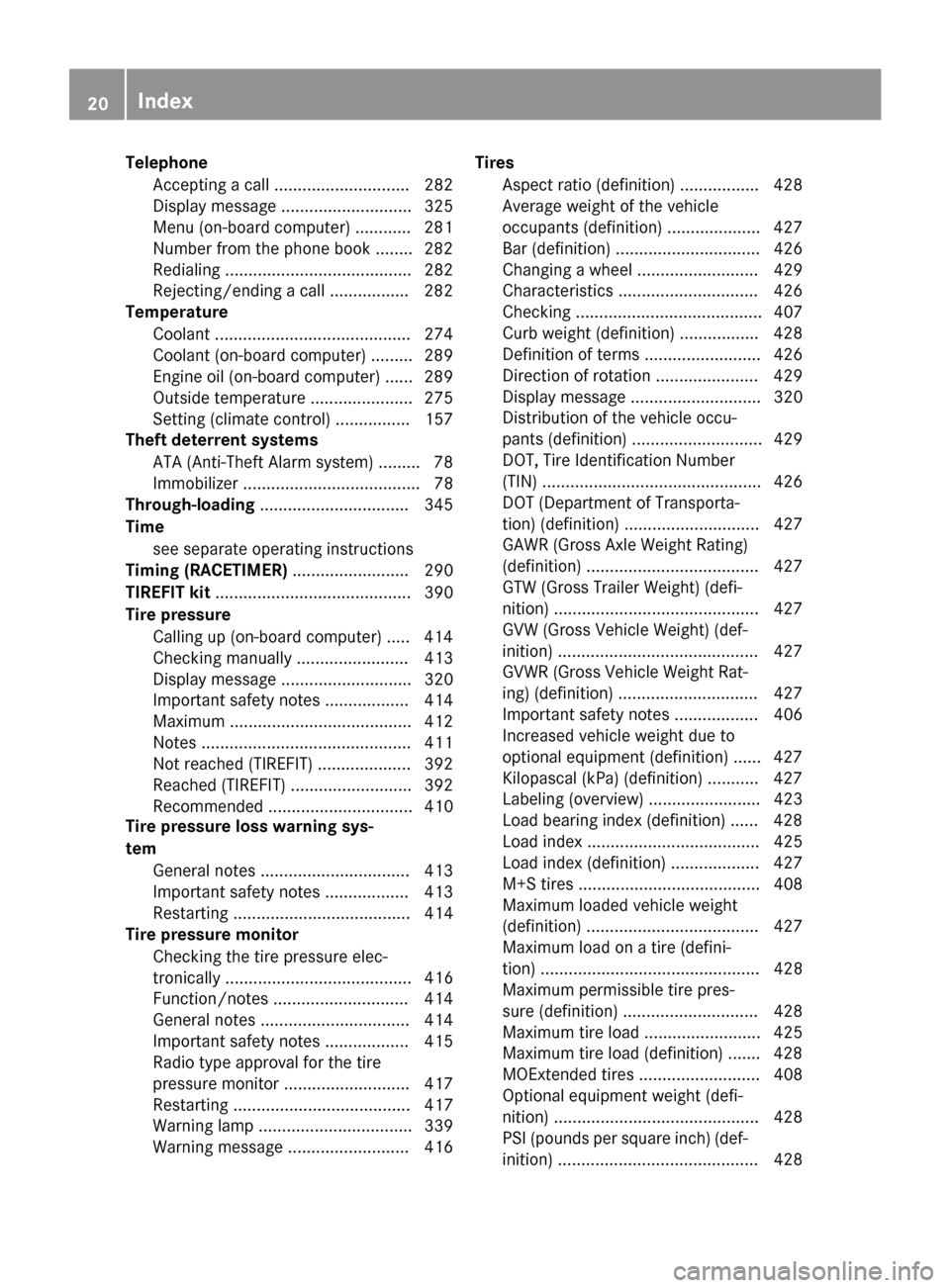
Telephone
Accepting a call ............................. 282
Display message ............................ 325
Menu (on-board computer) ............ 281
Number from the phone book ........ 282
Redialing ........................................ 282
Rejecting/ending a call ................. 282
Temperature
Coolant .......................................... 274
Coolant (on-board computer) ......... 289
Engine oil (on-board computer) ...... 289
Outside temperature ...................... 275
Setting (climate control) ................ 157
Theft deterrent systems
ATA (Anti-Theft Alarm system )......... 78
Immobilizer ...................................... 78
Through-loading ................................ 345
Time see separate operating instructions
Timing (RACETIMER) ......................... 290
TIREFIT kit .......................................... 390
Tire pressure Calling up (on-board computer) ..... 414
Checking manually ........................ 413
Display message ............................ 320
Important safety notes .................. 414
Maximum ....................................... 412
Notes ............................................. 411
Not reached (TIREFIT) .................... 392
Reached (TIREFIT) .......................... 392
Recommended ............................... 410
Tire pressure loss warning sys-
tem
General notes ................................ 413
Important safety notes .................. 413
Restarting ...................................... 414
Tire pressure monitor
Checking the tire pressure elec-
tronically ........................................ 416
Function/note s............................. 414
General notes ................................ 414
Important safety notes .................. 415
Radio type approval for the tire
pressure monitor ........................... 417
Restarting ...................................... 417
Warning lamp ................................. 339
Warning message .......................... 416 Tires
Aspect ratio (definition) ................. 428
Average weight of the vehicle
occupants (definition) .................... 427
Bar (definition) ............................... 426
Changing a whee l.......................... 429
Characteristics .............................. 426
Checking ........................................ 407
Curb weight (definition) ................. 428
Definition of terms ......................... 426
Direction of rotation ...................... 429
Display message ............................ 320
Distribution of the vehicle occu-
pants (definition) ............................ 429
DOT, Tire Identification Number
(TIN) ............................................... 426
DOT (Department of Transporta-
tion) (definition) ............................. 427
GAWR (Gross Axle Weight Rating)
(definition) ..................................... 427
GTW (Gross Trailer Weight) (defi-
nition) ............................................ 427
GVW (Gross Vehicle Weight) (def-
inition) ........................................... 427
GVWR (Gross Vehicle Weight Rat-
ing) (definition) .............................. 427
Important safety notes .................. 406
Increased vehicle weight due to
optional equipment (definition) ...... 427
Kilopascal (kPa) (definition) ........... 427
Labeling (overview) ........................ 423
Load bearing index (definition) ...... 428
Load index ..................................... 425
Load index (definition) ................... 427
M+S tire s....................................... 408
Maximum loaded vehicle weight
(definition) ..................................... 427
Maximum load on a tire (defini-
tion) ............................................... 428
Maximum permissible tire pres-
sure (definition) ............................. 428
Maximum tire load ......................... 425
Maximum tire load (definition) ....... 428
MOExtended tire s.......................... 408
Optional equipment weight (defi-
nition) ............................................ 428
PSI (pounds per square inch) (def-
inition) ........................................... 428 20
Index
Page 23 of 462
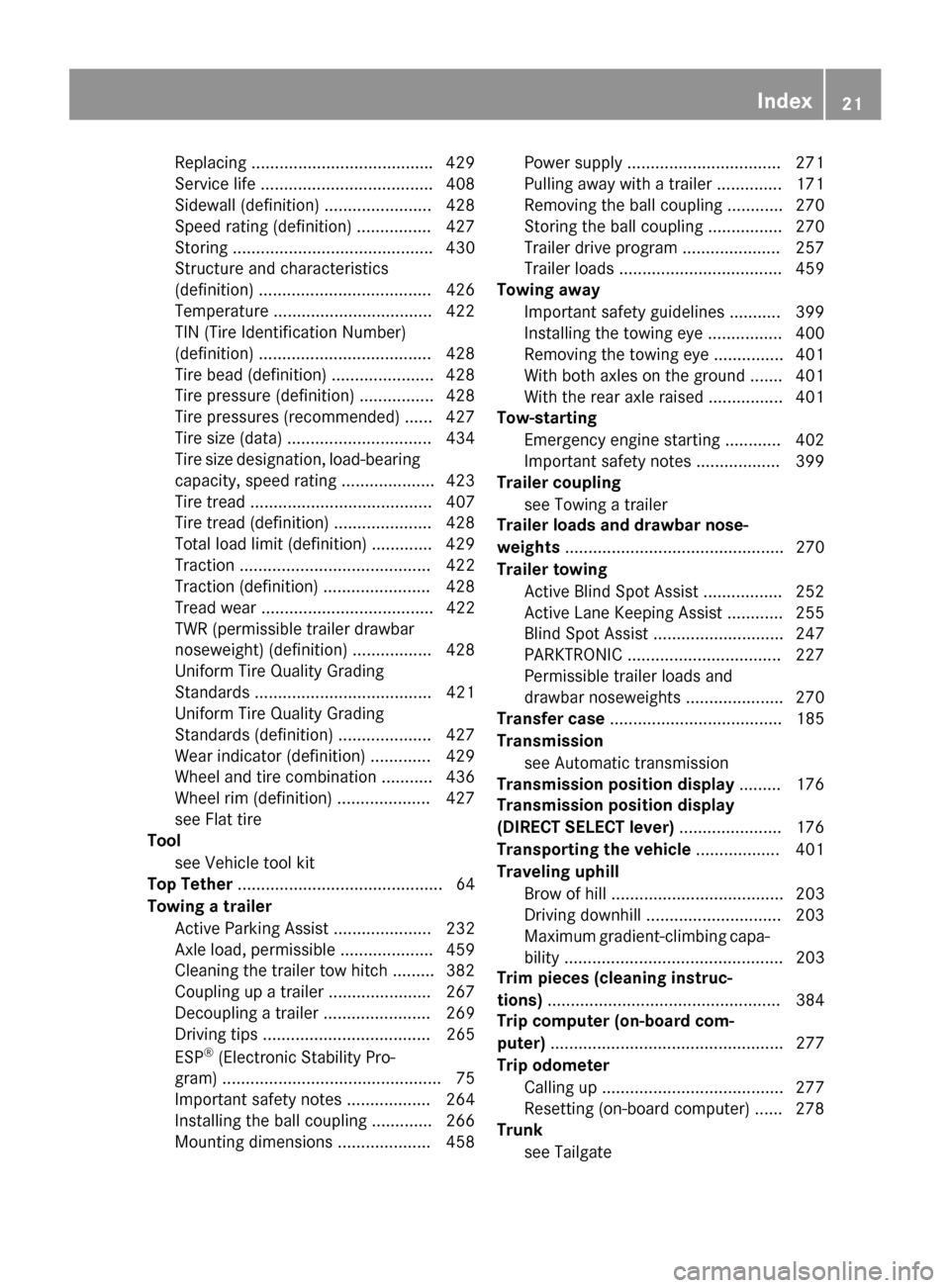
Replacin
g ...................................... .429
Service life ..................................... 408
Sidewall (definition) ....................... 428
Speed rating (definition) ................ 427
Storing .......................................... .430
Structure and characteristics
(definition) ..................................... 426
Temperature .................................. 422
TIN (Tire Identification Number)
(definition) ..................................... 428
Tire bead (definition) ..................... .428
Tire pressure (definition) ................ 428
Tire pressures (recommended) ...... 427
Tire size (data) ............................... 434
Tire size designation, load-bearing capacity, speed rating .................... 423
Tire tread ....................................... 407
Tire tread (definition) ..................... 428
Total load limit (definition) ............. 429
Traction ......................................... 422
Traction (definition) ....................... 428
Tread wea r..................................... 422
TWR (permissible trailer drawbar
noseweight) (definition) ................. 428
Uniform Tire Quality Grading
Standards ...................................... 421
Uniform Tire Quality Grading
Standards (definition) .................... 427
Wear indicator (definition) ............. 429
Wheel and tire combination ........... 436
Wheel rim (definition) .................... 427
see Flat tire
Tool
see Vehicle tool kit
Top Tether ............................................ 64
Towing a trailer Active Parking Assist ..................... 232
Axle load, permissibl e.................... 459
Cleaning the trailer tow hitch ......... 382
Coupling up a traile r...................... 267
Decoupling a traile r....................... 269
Driving tips .................................... 265
ESP ®
(Electronic Stability Pro-
gram) ............................................... 75
Important safety notes .................. 264
Installing the ball coupling ............. 266
Mounting dimensions .................... 458 Power supply ................................. 271
Pulling away with a traile
r.............. 171
Removing the ball coupling ............ 270
Storing the ball coupling ................ 270
Trailer drive progra m..................... 257
Trailer load s................................... 459
Towing away
Important safety guidelines ........... 399
Installing the towing eye ................ 400
Removing the towing eye ............... 401
With both axles on the ground ....... 401
With the rear axle raised ................ 401
Tow-starting
Emergency engine starting ............ 402
Important safety notes .................. 399
Trailer coupling
see Towing a trailer
Trailer loads and drawbar nose-
weights ............................................... 270
Trailer towing Active Blind Spot Assist ................. 252
Active Lane Keeping Assist ............ 255
Blind Spot Assist ............................ 247
PARKTRONIC ................................. 227
Permissible trailer loads and
drawbar noseweights ..................... 270
Transfer case ..................................... 185
Transmission see Automatic transmission
Transmission position display ......... 176
Transmission position display
(DIRECT SELECT lever) ...................... 176
Transporting the vehicle .................. 401
Traveling uphill Brow of hill ..................................... 203
Driving downhill ............................. 203
Maximum gradient-climbing capa-
bility ............................................... 203
Trim pieces (cleaning instruc-
tions) .................................................. 384
Trip computer (on-board com-
puter) .................................................. 277
Trip odometer Calling up ....................................... 277
Resetting (on-board computer) ...... 278
Trunk
see Tailgate Index
21
Page 24 of 462
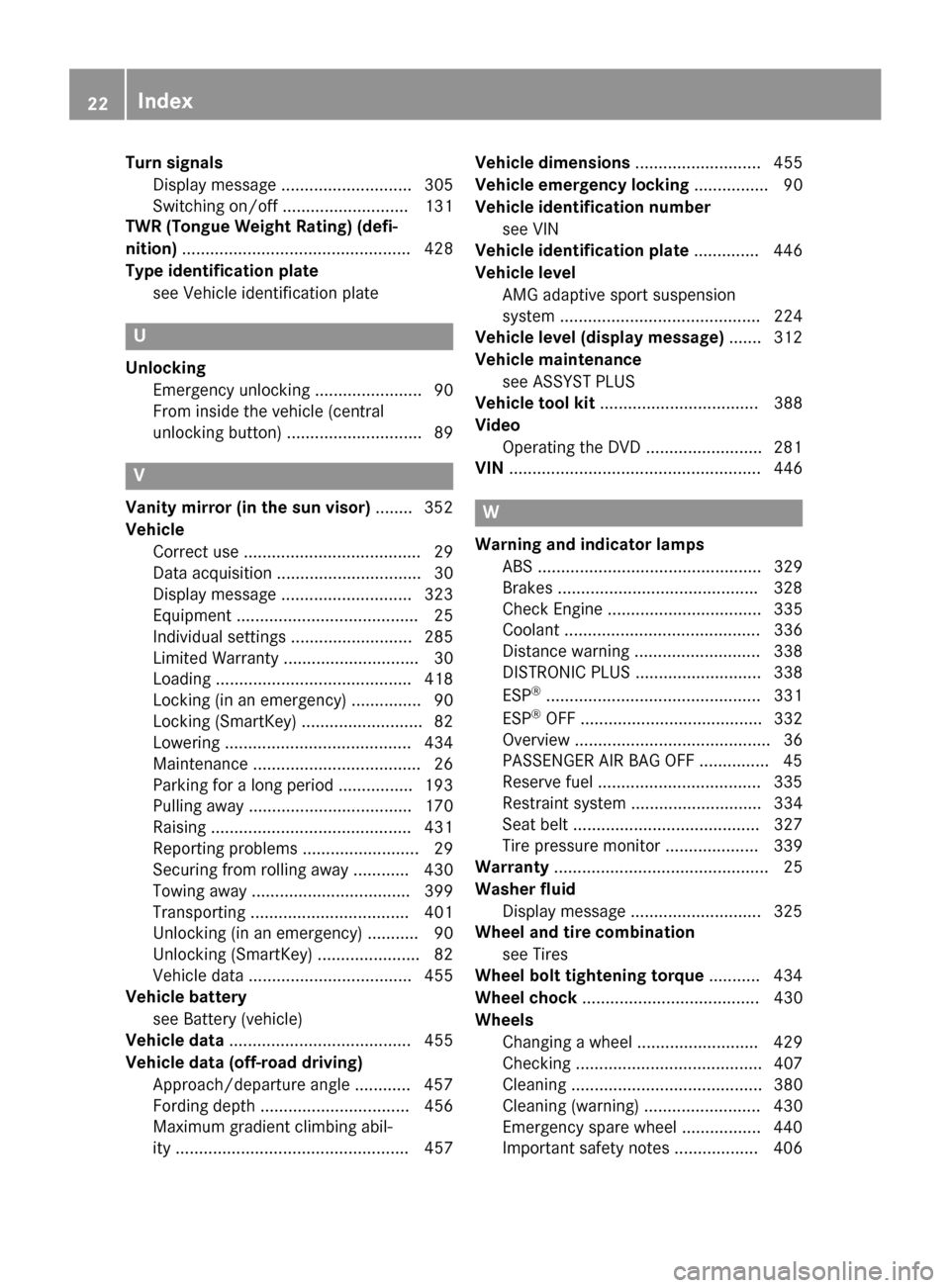
Turn signals
Display message ............................ 305
Switching on/off ........................... 131
TWR (Tongue Weight Rating) (defi-
nition) ................................................. 428
Type identification plate see Vehicle identification plate U
Unlocking Emergency unlocking ....................... 90
From inside the vehicle (central
unlocking button) ............................. 89 V
Vanity mirror (in the sun visor) ........ 352
Vehicle Correct use ...................................... 29
Data acquisition ............................... 30
Display message ............................ 323
Equipment ....................................... 25
Individual settings .......................... 285
Limited Warranty ............................. 30
Loading .......................................... 418
Locking (in an emergency) ............... 90
Locking (SmartKey) .......................... 82
Lowering ........................................ 434
Maintenance .................................... 26
Parking for a long period ................ 193
Pulling away ................................... 170
Raising ........................................... 431
Reporting problems ......................... 29
Securing from rolling away ............ 430
Towing away .................................. 399
Transporting .................................. 401
Unlocking (in an emergency) ........... 90
Unlocking (SmartKey) ...................... 82
Vehicle data ................................... 455
Vehicle battery
see Battery (vehicle)
Vehicle data ....................................... 455
Vehicle data (off-road driving) Approach/departure angle ............ 457
Fording depth ................................ 456
Maximum gradient climbing abil-
ity .................................................. 457 Vehicle dimensions
........................... 455
Vehicle emergency locking ................ 90
Vehicle identification number see VIN
Vehicle identification plate .............. 446
Vehicle level AMG adaptive sport suspension
system ........................................... 224
Vehicle level (display message) ....... 312
Vehicle maintenance see ASSYST PLUS
Vehicle tool kit .................................. 388
Video Operating the DVD ........................ .281
VIN ...................................................... 446 W
Warning and indicator lamps ABS ................................................ 329
Brakes .......................................... .328
Check Engine ................................. 335
Coolant .......................................... 336
Distance warning ........................... 338
DISTRONIC PLUS ........................... 338
ESP ®
.............................................. 331
ESP ®
OFF ....................................... 332
Overview .......................................... 36
PASSENGER AIR BAG OFF .............. .45
Reserve fuel .................................. .335
Restraint system ............................ 334
Seat belt ........................................ 327
Tire pressure monitor .................... 339
Warranty .............................................. 25
Washer fluid Display message ............................ 325
Wheel and tire combination
see Tires
Wheel bolt tightening torque ........... 434
Wheel chock ...................................... 430
Wheels Changing a wheel .......................... 429
Checking ........................................ 407
Cleaning ......................................... 380
Cleaning (warning) ......................... 430
Emergency spare wheel ................. 440
Important safety notes .................. 406 22
Index
Page 26 of 462

Protection of the environment
General notes
H
Environmental note
Daimler's declared policy is one of compre-
hensive environmental protection.
The objectives are for the natural resources
that form the basis of our existence on this
planet to be used sparingly and in a manner
that takes the requirements of both nature
and humanity into account.
You too can help to protect the environment
by operating your vehicle in an environmen-
tally responsible manner.
Fuel consumption and the rate of engine,
transmission, brake and tire wear are affected by these factors:
R operating conditions of your vehicle
R your personal driving style
You can influence both factors. You should
bear the following in mind:
Operating conditions:
R avoid short trips as these increase fuel con-
sumption.
R always make sure that the tire pressures
are correct.
R do not carry any unnecessary weight.
R remove roof racks once you no longer need
them.
R a regularly serviced vehicle will contribute
to environmental protection. You should
therefore adhere to the service intervals.
R always have service work carried out at a
qualified specialist workshop.
Personal driving style:
R do not depress the accelerator pedal when
starting the engine.
R do not warm up the engine when the vehicle
is stationary.
R drive carefully and maintain a safe distance
from the vehicle in front.
R avoid frequent, sudden acceleration and
braking. R
change gear in good time and use each gear
only up to 00C3of its maximum engine speed.
R switch off the engine in stationary traffic.
R keep an eye on the vehicle's fuel consump-
tion. Environmental concerns and recom-
mendations
Wherever the operating instructions require
you to dispose of materials, first try to regen-
erate or re-use them. Observe the relevant
environmental rules and regulations when
disposing of materials. In this way you will
help to protect the environment. Genuine Mercedes-Benz parts
H
Environmental note
Daimler AG also supplies reconditioned major
assemblies and parts which are of the same
quality as new parts. They are covered by the same Limited Warranty entitlements as new
parts.
! Air bags and Emergency Tensioning Devi-
ces, as well as control units and sensors for these restraint systems, may be installed inthe following areas of your vehicle:
R doors
R door pillars
R door sills
R seats
R cockpit
R instrument cluster
R center console
Do not install accessories such as audio
systems in these areas. Do not carry out
repairs or welding. You could impair the
operating efficiency of the restraint sys-
tems.
Have aftermarket accessories installed at a qualified specialist workshop. 24
Introduction
Page 49 of 462
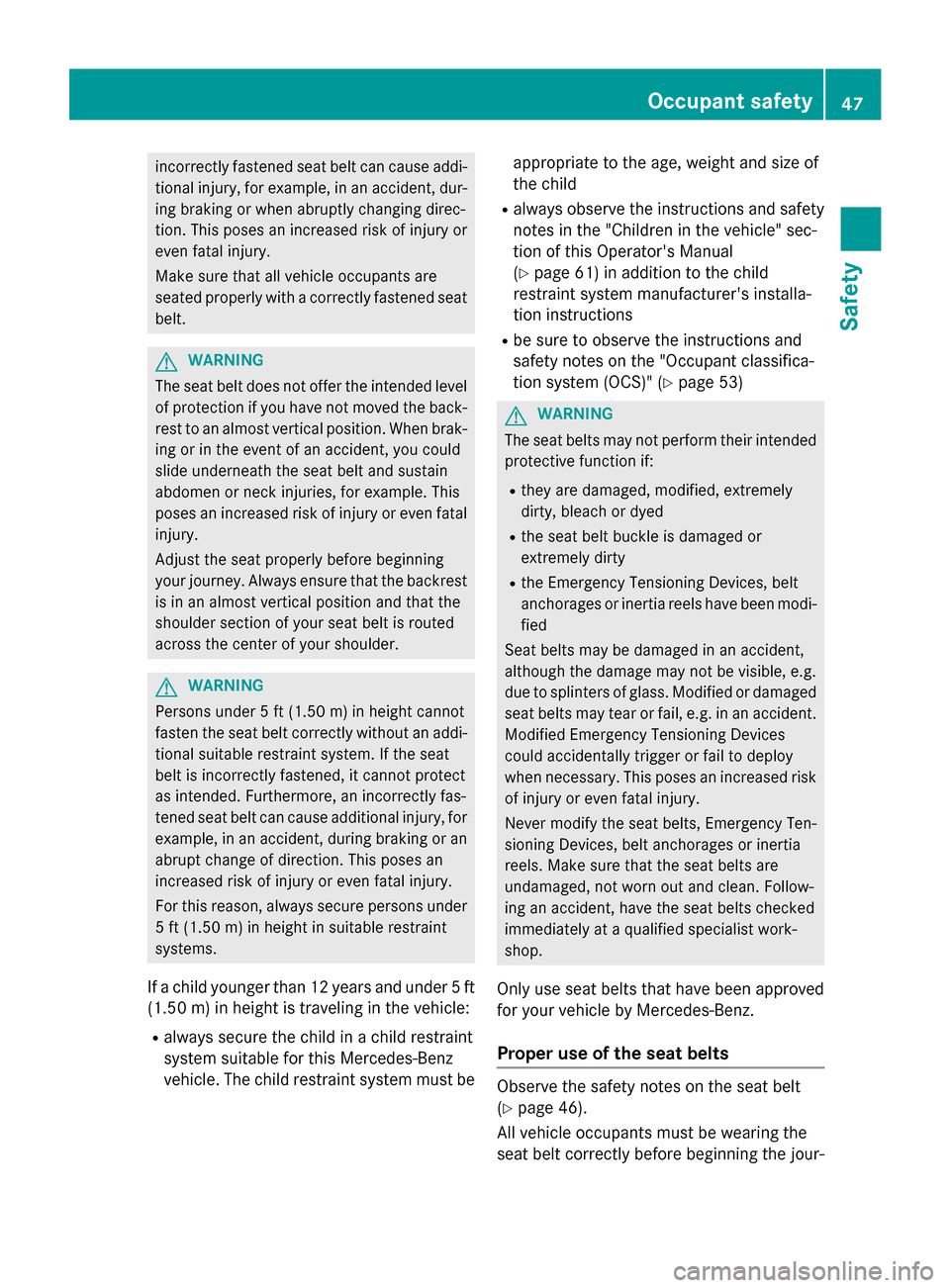
incorrectly fastened seat belt can cause addi-
tional injury, for example, in an accident, dur-
ing braking or when abruptly changing direc-
tion. This poses an increased risk of injury or
even fatal injury.
Make sure that all vehicle occupants are
seated properly with a correctly fastened seat belt. G
WARNING
The seat belt does not offer the intended level of protection if you have not moved the back-
rest to an almost vertical position. When brak-
ing or in the event of an accident, you could
slide underneath the seat belt and sustain
abdomen or neck injuries, for example. This
poses an increased risk of injury or even fatal injury.
Adjust the seat properly before beginning
your journey. Always ensure that the backrest
is in an almost vertical position and that the
shoulder section of your seat belt is routed
across the center of your shoulder. G
WARNING
Persons under 5 ft (1.50 m) in height cannot
fasten the seat belt correctly without an addi- tional suitable restraint system. If the seat
belt is incorrectly fastened, it cannot protect
as intended. Furthermore, an incorrectly fas-
tened seat belt can cause additional injury, for
example, in an accident, during braking or an
abrupt change of direction. This poses an
increased risk of injury or even fatal injury.
For this reason, always secure persons under
5 ft (1.50 m) in height in suitable restraint
systems.
If a child younger than 12 years and under 5 ft
(1.50 m) in height is traveling in the vehicle:
R always secure the child in a child restraint
system suitable for this Mercedes-Benz
vehicle. The child restraint system must be appropriate to the age, weight and size of
the child
R always observe the instructions and safety
notes in the "Children in the vehicle" sec-
tion of this Operator's Manual
(Y page 61) in addition to the child
restraint system manufacturer's installa-
tion instructions
R be sure to observe the instructions and
safety notes on the "Occupant classifica-
tion system (OCS)" (Y page 53) G
WARNING
The seat belts may not perform their intended protective function if:
R they are damaged, modified, extremely
dirty, bleach or dyed
R the seat belt buckle is damaged or
extremely dirty
R the Emergency Tensioning Devices, belt
anchorages or inertia reels have been modi-
fied
Seat belts may be damaged in an accident,
although the damage may not be visible, e.g.
due to splinters of glass. Modified or damaged
seat belts may tear or fail, e.g. in an accident. Modified Emergency Tensioning Devices
could accidentally trigger or fail to deploy
when necessary. This poses an increased risk
of injury or even fatal injury.
Never modify the seat belts, Emergency Ten-
sioning Devices, belt anchorages or inertia
reels. Make sure that the seat belts are
undamaged, not worn out and clean. Follow-
ing an accident, have the seat belts checked
immediately at a qualified specialist work-
shop.
Only use seat belts that have been approved
for your vehicle by Mercedes-Benz.
Proper use of the seat belts Observe the safety notes on the seat belt
(Y
page 46).
All vehicle occupants must be wearing the
seat belt correctly before beginning the jour- Occupant safety
47Safety Z
Page 55 of 462
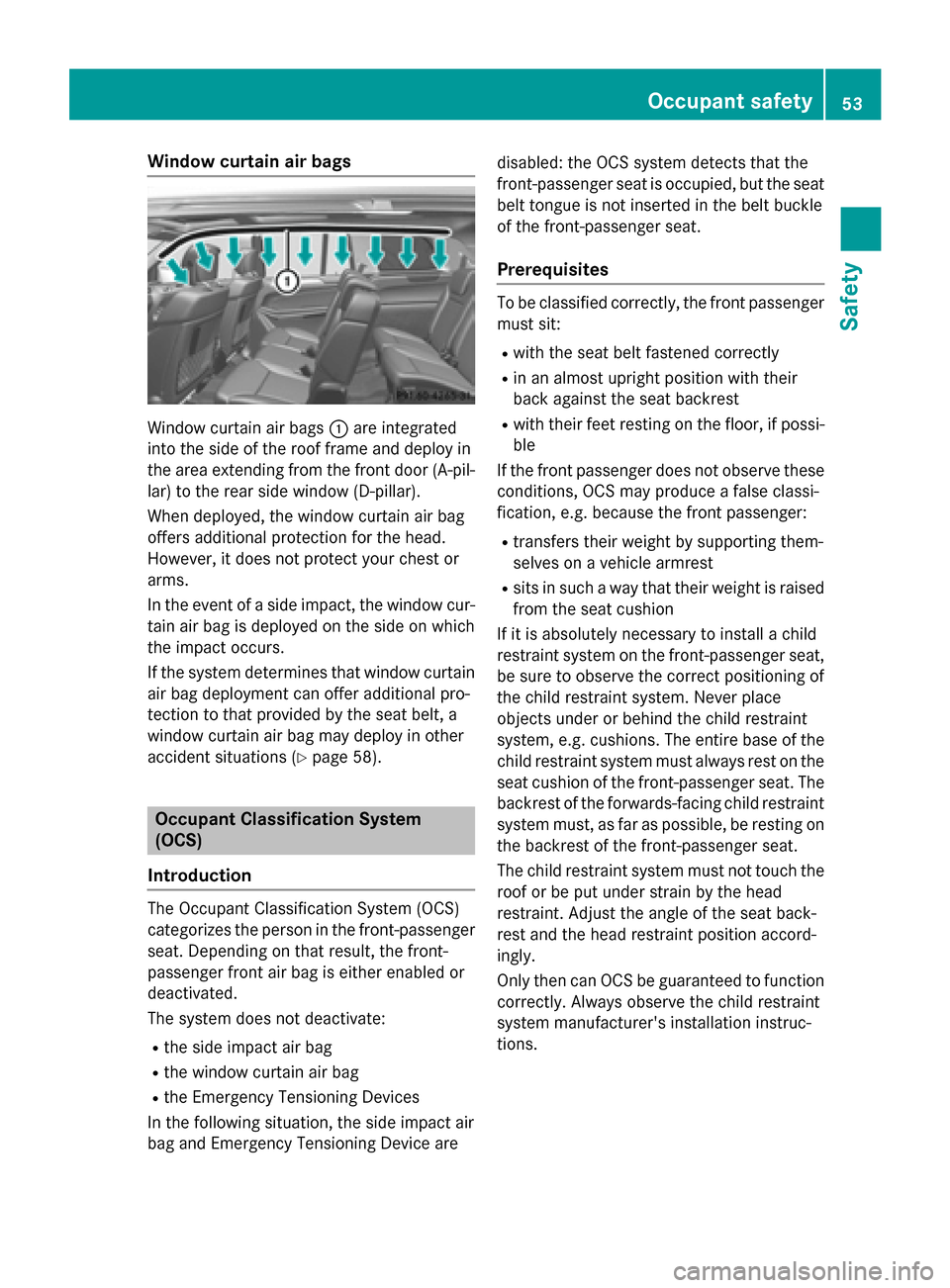
Window curtain air bags
Window curtain air bags
0043are integrated
into the side of the roof frame and deploy in
the area extending from the front door (A-pil-
lar) to the rear side window (D-pillar).
When deployed, the window curtain air bag
offers additional protection for the head.
However, it does not protect your chest or
arms.
In the event of a side impact, the window cur-
tain air bag is deployed on the side on which
the impact occurs.
If the system determines that window curtain
air bag deployment can offer additional pro-
tection to that provided by the seat belt, a
window curtain air bag may deploy in other
accident situations (Y page 58).Occupant Classification System
(OCS)
Introduction The Occupant Classification System (OCS)
categorizes the person in the front-passenger
seat. Depending on that result, the front-
passenger front air bag is either enabled or
deactivated.
The system does not deactivate:
R the side impact air bag
R the window curtain air bag
R the Emergency Tensioning Devices
In the following situation, the side impact air
bag and Emergency Tensioning Device are disabled: the OCS system detects that the
front-passenger seat is occupied, but the seat
belt tongue is not inserted in the belt buckle
of the front-passenger seat.
Prerequisites To be classified correctly, the front passenger
must sit:
R with the seat belt fastened correctly
R in an almost upright position with their
back against the seat backrest
R with their feet resting on the floor, if possi-
ble
If the front passenger does not observe these conditions, OCS may produce a false classi-
fication, e.g. because the front passenger:
R transfers their weight by supporting them-
selves on a vehicle armrest
R sits in such a way that their weight is raised
from the seat cushion
If it is absolutely necessary to install a child
restraint system on the front-passenger seat,
be sure to observe the correct positioning of
the child restraint system. Never place
objects under or behind the child restraint
system, e.g. cushions. The entire base of the
child restraint system must always rest on the
seat cushion of the front-passenger seat. The
backrest of the forwards-facing child restraint
system must, as far as possible, be resting on the backrest of the front-passenger seat.
The child restraint system must not touch the roof or be put under strain by the head
restraint. Adjust the angle of the seat back-
rest and the head restraint position accord-
ingly.
Only then can OCS be guaranteed to function
correctly. Always observe the child restraint
system manufacturer's installation instruc-
tions. Occupant safety
53Safety Z
Page 59 of 462
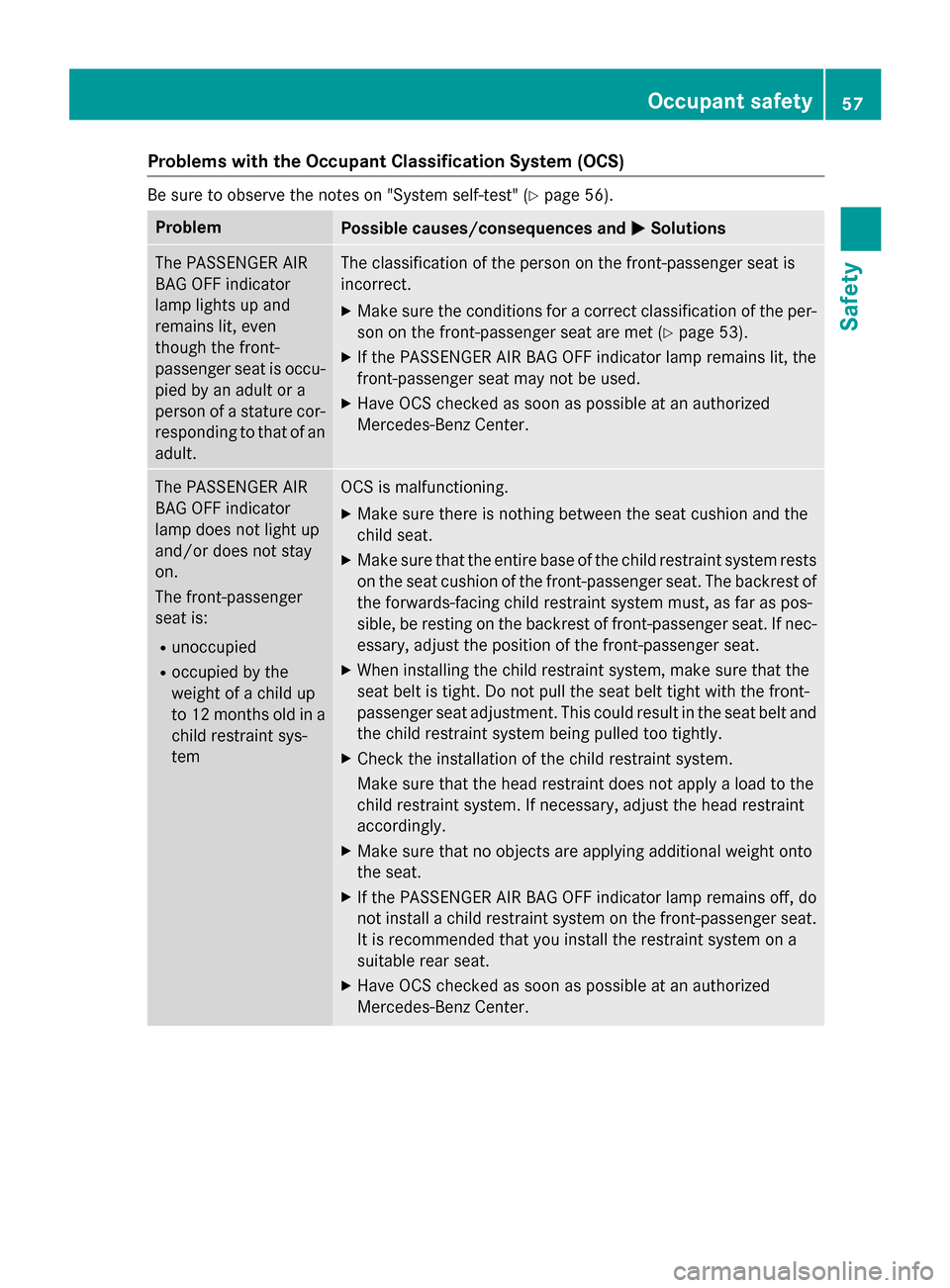
Problems with the Occupant Classification System (OCS)
Be sure to observe the notes on "System self-test" (Y
page 56).Problem
Possible causes/consequences and
0050
0050Solutions The PASSENGER AIR
BAG OFF indicator
lamp lights up and
remains lit, even
though the front-
passenger seat is occu-
pied by an adult or a
person of a stature cor-
responding to that of an
adult. The classification of the person on the front-passenger seat is
incorrect.
X Make sure the conditions for a correct classification of the per-
son on the front-passenger seat are met (Y page 53).
X If the PASSENGER AIR BAG OFF indicator lamp remains lit, the
front-passenger seat may not be used.
X Have OCS checked as soon as possible at an authorized
Mercedes-Benz Center. The PASSENGER AIR
BAG OFF indicator
lamp does not light up
and/or does not stay
on.
The front-passenger
seat is:
R unoccupied
R occupied by the
weight of a child up
to 12 months old in a
child restraint sys-
tem OCS is malfunctioning.
X Make sure there is nothing between the seat cushion and the
child seat.
X Make sure that the entire base of the child restraint system rests
on the seat cushion of the front-passenger seat. The backrest of
the forwards-facing child restraint system must, as far as pos-
sible, be resting on the backrest of front-passenger seat. If nec- essary, adjust the position of the front-passenger seat.
X When installing the child restraint system, make sure that the
seat belt is tight. Do not pull the seat belt tight with the front-
passenger seat adjustment. This could result in the seat belt and the child restraint system being pulled too tightly.
X Check the installation of the child restraint system.
Make sure that the head restraint does not apply a load to the
child restraint system. If necessary, adjust the head restraint
accordingly.
X Make sure that no objects are applying additional weight onto
the seat.
X If the PASSENGER AIR BAG OFF indicator lamp remains off, do
not install a child restraint system on the front-passenger seat. It is recommended that you install the restraint system on a
suitable rear seat.
X Have OCS checked as soon as possible at an authorized
Mercedes-Benz Center. Occupant safety
57Safety Z
Page 63 of 462
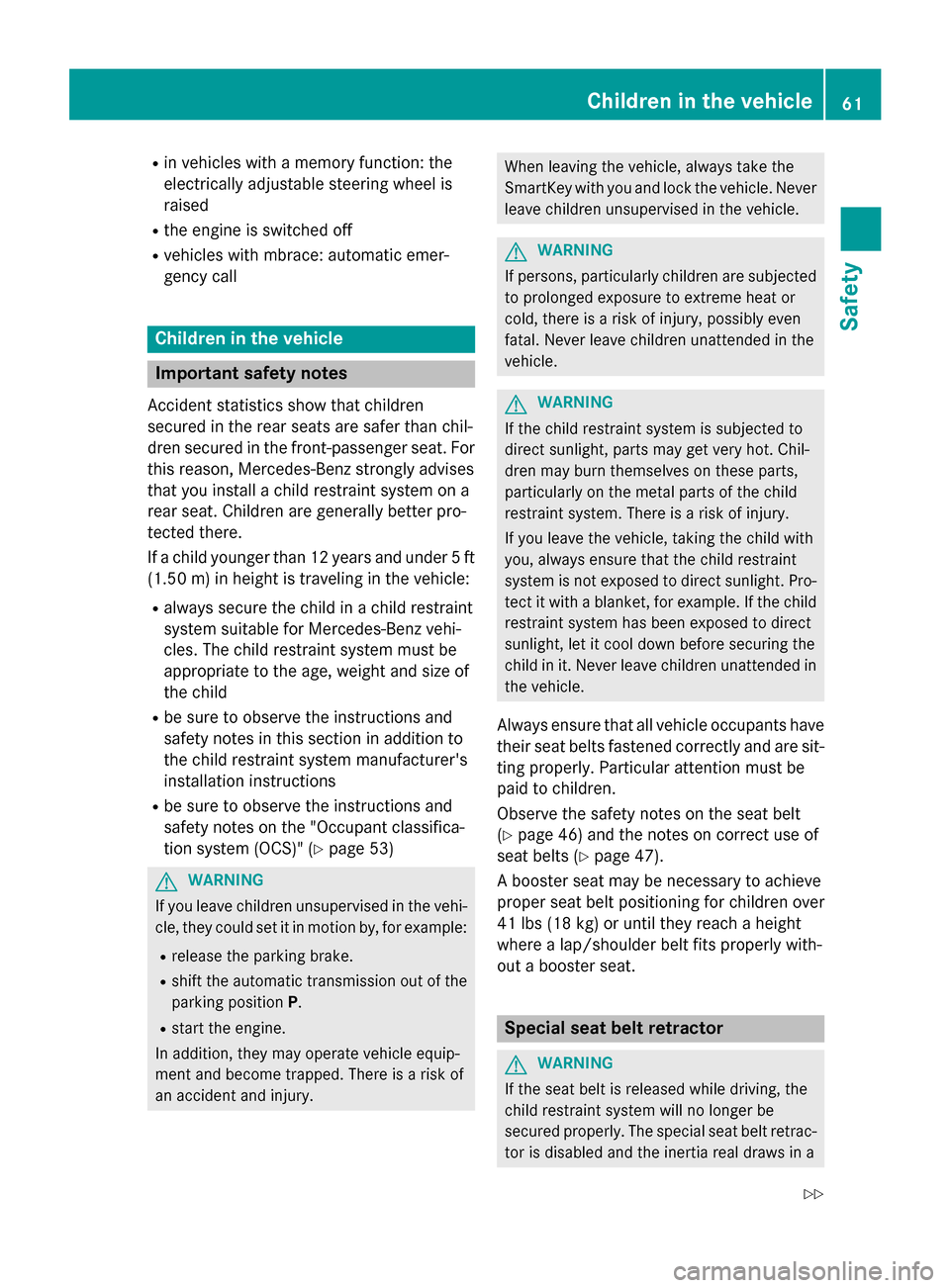
R
in vehicles with a memory function: the
electrically adjustable steering wheel is
raised
R the engine is switched off
R vehicles with mbrace: automatic emer-
gency call Children in the vehicle
Important safety notes
Accident statistics show that children
secured in the rear seats are safer than chil-
dren secured in the front-passenger seat. For this reason, Mercedes-Benz strongly advises
that you install a child restraint system on a
rear seat. Children are generally better pro-
tected there.
If a child younger than 12 years and under 5 ft
(1.50 m) in height is traveling in the vehicle:
R always secure the child in a child restraint
system suitable for Mercedes-Benz vehi-
cles. The child restraint system must be
appropriate to the age, weight and size of
the child
R be sure to observe the instructions and
safety notes in this section in addition to
the child restraint system manufacturer's
installation instructions
R be sure to observe the instructions and
safety notes on the "Occupant classifica-
tion system (OCS)" (Y page 53)G
WARNING
If you leave children unsupervised in the vehi- cle, they could set it in motion by, for example:
R release the parking brake.
R shift the automatic transmission out of the
parking position P.
R start the engine.
In addition, they may operate vehicle equip-
ment and become trapped. There is a risk of
an accident and injury. When leaving the vehicle, always take the
SmartKey with you and lock the vehicle. Never
leave children unsupervised in the vehicle. G
WARNING
If persons, particularly children are subjected to prolonged exposure to extreme heat or
cold, there is a risk of injury, possibly even
fatal. Never leave children unattended in the
vehicle. G
WARNING
If the child restraint system is subjected to
direct sunlight, parts may get very hot. Chil-
dren may burn themselves on these parts,
particularly on the metal parts of the child
restraint system. There is a risk of injury.
If you leave the vehicle, taking the child with
you, always ensure that the child restraint
system is not exposed to direct sunlight. Pro- tect it with a blanket, for example. If the child
restraint system has been exposed to direct
sunlight, let it cool down before securing the
child in it. Never leave children unattended in the vehicle.
Always ensure that all vehicle occupants have
their seat belts fastened correctly and are sit- ting properly. Particular attention must be
paid to children.
Observe the safety notes on the seat belt
(Y page 46) and the notes on correct use of
seat belts (Y page 47).
A booster seat may be necessary to achieve
proper seat belt positioning for children over
41 lbs (18 kg) or until they reach a height
where a lap/shoulder belt fits properly with-
out a booster seat. Special seat belt retractor
G
WARNING
If the seat belt is released while driving, the
child restraint system will no longer be
secured properly. The special seat belt retrac- tor is disabled and the inertia real draws in a Children in the vehicle
61Safety
Z
Page 65 of 462
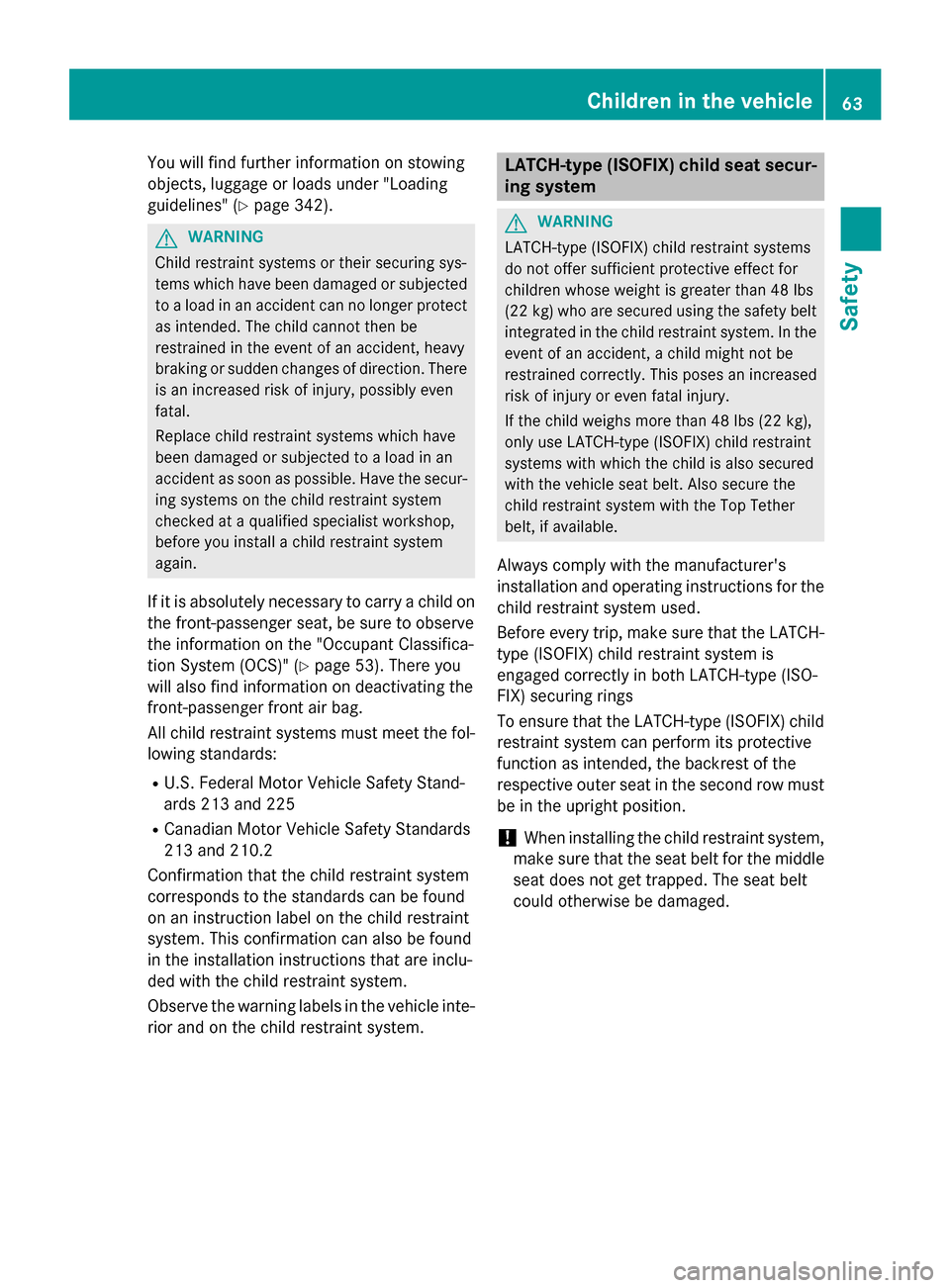
You will find further information on stowing
objects, luggage or loads under "Loading
guidelines" (Y page 342). G
WARNING
Child restraint systems or their securing sys-
tems which have been damaged or subjected to a load in an accident can no longer protect
as intended. The child cannot then be
restrained in the event of an accident, heavy
braking or sudden changes of direction. There is an increased risk of injury, possibly even
fatal.
Replace child restraint systems which have
been damaged or subjected to a load in an
accident as soon as possible. Have the secur-
ing systems on the child restraint system
checked at a qualified specialist workshop,
before you install a child restraint system
again.
If it is absolutely necessary to carry a child on the front-passenger seat, be sure to observe
the information on the "Occupant Classifica-
tion System (OCS)" (Y page 53). There you
will also find information on deactivating the
front-passenger front air bag.
All child restraint systems must meet the fol- lowing standards:
R U.S. Federal Motor Vehicle Safety Stand-
ards 213 and 225
R Canadian Motor Vehicle Safety Standards
213 and 210.2
Confirmation that the child restraint system
corresponds to the standards can be found
on an instruction label on the child restraint
system. This confirmation can also be found
in the installation instructions that are inclu-
ded with the child restraint system.
Observe the warning labels in the vehicle inte-
rior and on the child restraint system. LATCH-type (ISOFIX) child seat secur-
ing system G
WARNING
LATCH-type (ISOFIX) child restraint systems
do not offer sufficient protective effect for
children whose weight is greater than 48 lbs
(22 kg) who are secured using the safety belt integrated in the child restraint system. In the
event of an accident, a child might not be
restrained correctly. This poses an increased
risk of injury or even fatal injury.
If the child weighs more than 48 lbs (22 kg),
only use LATCH-type (ISOFIX) child restraint
systems with which the child is also secured
with the vehicle seat belt. Also secure the
child restraint system with the Top Tether
belt, if available.
Always comply with the manufacturer's
installation and operating instructions for the child restraint system used.
Before every trip, make sure that the LATCH- type (ISOFIX) child restraint system is
engaged correctly in both LATCH-type (ISO-
FIX) securing rings
To ensure that the LATCH-type (ISOFIX) child
restraint system can perform its protective
function as intended, the backrest of the
respective outer seat in the second row must be in the upright position.
! When installing the child restraint system,
make sure that the seat belt for the middle
seat does not get trapped. The seat belt
could otherwise be damaged. Children in the vehicle
63Safety Z